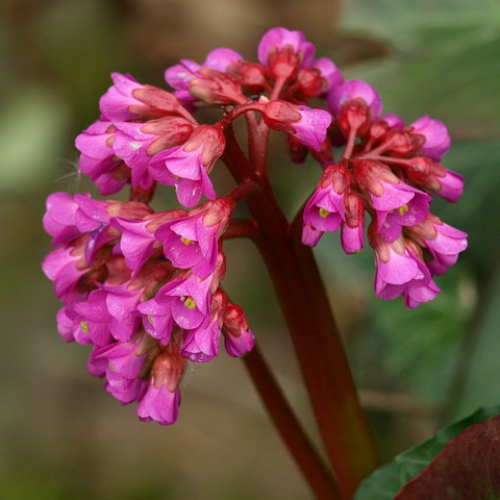Perennials Bergeniа

Description
Special features of Badan
Badan or Bergenia is a genus of mostly perennial plants belonging to the saxifrage family Saxifragaceae. Wild Badan occurs in Asia, among the rocks or cliffs, in alpine meadows and forest edges. The plant was named in honour of the botanist Karl August von Bergen.
Badan has a thick brown rhizome located near the soil surface with adventitious roots. The stems are erect, reaching 15-50 centimeters tall. The evergreen leaves are highly ornamental. They are large, rounded and gathered in a rosette. Their color is variable. In the spring and summer, the leaves are dark green; in the autumn, the leaves gradually turn to crimson and burgundy. This is caused by sugar accumulation, which helps Badan survive in winter. The flowers are also attractive. They are small (1-2 centimeters in diameter), collected in panicles, scarlet, pink, purple or off-white and glass-shaped. Flowering occurs in the spring and lasts for about six weeks. Some varieties rebloom in the autumn. The fruit is a capsule with small (about 2 millimeters) smooth black seeds.
Badan has been cultivated since the 18th century, but in our country has not yet won a well-deserved popularity. This plant can be used in any type of planting. It looks great in edges, mixed borders, borders, stony hills, or near ponds. The perfect companions for Badan are Daylily, Astilbe, Crocuses, Rhododendrons, Junipers, Irises, Speedwell, Geranium, Euonymus, Ferns, and trees such as the maple, mountain ash and cherry. From early spring to late autumn, this exquisite ornamental plant pleases eyes.
In addition, Badan is widely used in everyday life and medicine. Its dried overwintered leaves are used for Mongolian (Chigir) tea is famous for healthy properties. Badan rhizomes rich in tannins, starch, volatile productions, vitamin C, manganese, iron and copper have anti-inflammatory, antimicrobial and hemostatic effect and are used for colds, flu, hypertension, tuberculosis and other diseases.
The genus of Badan is represented by 10 species:
Bergenia crassifolia occurs mainly in rocky areas and among the stones, grows to 50 centimeters tall and features oval leaves and white, purple or pinkish purple flowers. This is the species most often used in medicine and landscape design.
Vergenia cordifolia. Some scientists believe this to be a Crassifolia variety. It is characterized by heart-shaped leaves and white, purple or violet pink flowers. This plant requires no cover in our climate and withstands temperature dropt to -40 ° C.
Vergenia stracheyi prefers moist areas. It has large oval leaves with toothed edges and white or purple flowers that bloom in mid-summer.
Vergenia ciliata has bristly leaves, white or pale pink flowers and early flowering.
Vergenia ligulata has leaves pubescent along the edges and white pink flowers.
Vergenia pacifica has round pale green leaves with small teeth on the edges and rich pink flowers.
Vergenia schmidtii is hybrid of Bergenia crassifolia and Vergenia ciliata and has oval serrated leaves with so-called "wings" and bright pink flowers.
Vergenia ugamica is an endangered species endemic the Ugam ridge. It has attractive elliptical leaves and crimson flowers. It blooms in midsummer.
Vergenia hissarica is a rare species. The plant grows to 25 centimeters tall, with white and pink flowers that bloom in late spring.
Vergenia hybrid is a very common garden culture species that includes different varieties, for example: ‘Abendglocken' (purple flowers), ‘Bressingham White' (white flowers), ‘Ballawley' (bright red flowers), ‘Baby Doll' (beige and pink flowers), ‘Glockenturm' (grows to half a meter, rich pink flowers), ‘Sunshade' (pinkish purple flowers).
The Secrets to Successfully Growing Badan
This plant is very hardy but it will thrive in a partially shaded location with lightweight fertile neutral or weak acidic soil and good drainage, as Badan does not tolerate stagnant water. In the spring and autumn, it is good to use mineral fertilizers. The basic care for Badane includes regular watering during drought, soil mulching and removing old lower leaves. In the spring, cut the leaves damaged during the winter and feed the plant so that it will start to develop new foliage.
Most of Badan species safely overwinter without sheltering. Only certain particularly sensitive varieties and young plants need to be covered with a thin layer of dry leaves. Frequent replanting is not required either. Badan can grow for about 10 year in the same place.
Badan is propagated by seeds, cuttings, and rhizome segments.
Propagation by seed requires patience, time, and good care. Seeds are sown in the early spring or winter in containers and grown there for the first 2 years. Remember to water regularly, protect from direct sunlight and prick out. On the third year in July, plant the seedlings in the open ground spacing them 40-50 centimeters apart.
Propagation by cuttings is easier. Prepare healthy cuttings after flowering in the spring (about 15 centimeters long) with at least three buds, leave only 3 young leaves on them and plant them 3-5 centimeters deep and 30-50 centimeters apart. Water regularly. In 2 week, they will take root.
The most popular propatation type is by rhizome segments. In the early autumn or spring, dig up the rhizome, wash with a pink potassium permanganate solution, divide into parts with 2-3 leaves, and plant in a prepared location. Do not plant deep.
Potential Problems
If replanted frequently, Badan can get sick so choose the most appropriate location beforehand. Some varieties spring frost tender. Consider this when choosing a location for growing Badan. Frost is usually not as strong near trees and buildings as in low and open areas.
If waterlogged, Badan may be stricken by bacterial spotting. Brown spots appear on the upper surface of leaves and a white film on the underside. At the first sign of the disease, remove the affected leaves and apply Fundasole or Bordeaux liquid.
Sometimes the plant can be attacked by weevils, snails, slugs, or caterpillars. Immediately remove the pests and spray the plants with insecticides.







 334
334






